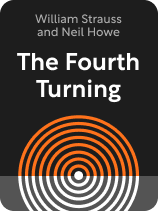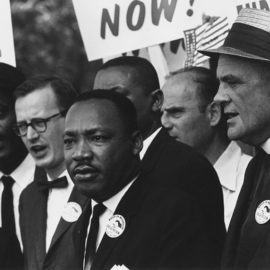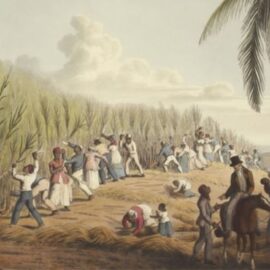

This article is an excerpt from the Shortform book guide to "The Fourth Turning" by William Strauss and Neil Howe. Shortform has the world's best summaries and analyses of books you should be reading.
Like this article? Sign up for a free trial here.
When did the Culture Wars in America start? What were the wars about? What values came to the fore?
William Strauss and Neil Howe wrote The Fourth Turning in 1997, in the midst of America’s most recent Third Turning—the third phase in a four-phase cycle of history. The authors describe the Third Turning in general as an Unraveling. They call the Third Turning which began in 1984 “the Culture Wars.”
Read more to learn about the Culture Wars in America and how they fit into the larger historical picture.
What Are the “Turnings”?
Strauss and Howe explain that human history is characterized by a cyclical progression through four “Turnings.” Each Turning lasts around 15 to 25 years. According to the authors, the First Turning is a High, the Second Turning is an Awakening, the Third Turning is an Unraveling, and the Fourth Turning is a Crisis.
The Culture Wars in America define the most recent Third Turning that the authors describe. Before we dive into those specifics, let’s take a look at Third Turnings in general to lay the groundwork.
The Third Turning: An Unraveling
The authors describe the Third Turning as an Unraveling. An Unraveling occurs when society embraces the new order put in place during the Awakening. Trust in government and establishments continues to decline, and people become more passionate about and extreme in their beliefs. Communities become divided over morals, and unified action becomes more difficult. People begin to feel like they’re hurtling toward a catastrophe.
People become tribal or nationalistic and suspicious of anything that doesn’t fit their values. Individualism is at its highest, government power stagnates, and free markets become even more favored. Violence, crime, and income inequality reach their peak. Gender divisions are even less strict, and society becomes more protective of children.
(Shortform note: The sense of impending cataclysm during an Unraveling may help explain the psychology behind the extremism that grows in this period. Research suggests that when we perceive potential risks, we’re compelled to seek safety among groups, and these groups are often ideological in nature. The greater our sense of danger, the more closely we adhere to such group ideologies, and the stronger and more polarized our beliefs become. During an Unraveling, these perceived dangers would be exacerbated by increased crime and inequality, further eroding trust in large organizations and cementing trust in tribal groups.)
America’s Most Recent Third Turning: The Culture Wars
The Culture Wars in America following the Consciousness Revolution began in 1984 and were still ongoing at the time of this book’s publication in 1997. The authors roughly estimated that it would last through 2005 but acknowledged that it could end a few years earlier or later. During this time, the new system of individualistic values established during the Awakening had become part of mainstream culture.
(Shortform note: In 2020, Neil Howe addressed the events that had taken place since his book’s publication and identified the 2008 financial crisis as the Fourth Turning’s catalyst, which would establish the dates of the Third Turning as 1984 to 2008.)
The elder Silent Artist generation led ineffectually and indecisively during this time. Though this was the era when they should have been dominating the highest leadership roles, they failed to produce a single president during this Turning, a generational anomaly that had never happened before in U.S. history. They instead took on helper roles as White House staff and congresspeople, but the authors note that their generation of leaders has become notorious for working diligently but getting very little done. They explain that, compared to the G.I. leaders in the 1960s, the Silent leaders in the 1980s had twice as many hearings and four times the staff, but only one-third as many laws passed.
(Shortform note: The Silent generation did eventually see a president elected in 2020 with Joe Biden, though as of 2021 they made up only about 7% of Congress, vastly outnumbered by Boomers. Furthermore, accusations of government laziness and inaction have been directed at various administrations for decades but have picked up steam recently, partially as a result of increasing political polarization, which makes it more difficult to reach bipartisan compromises. Biden hasn’t been immune to these accusations, as critics have pointed to a lack of action on his part to stop such changes as the Supreme Court’s overturning of Roe v. Wade. However, supporters of the president have praised his commitment to non-confrontational compromise.)
Meanwhile, Boomer Prophets entered midlife as judgmental leaders heavily fixated on black-and-white values that they were unwilling to compromise on. Xennial Nomads came into adulthood feeling alienated and ignored and with a fragmented generational identity.
(Shortform note: Strauss and Howe’s assessment of Boomers may seem somewhat harsh, but other writers describe the generation similarly, even suggesting that it’s a generation of sociopaths. However, other experts note that animosity between generations is unproductive and fails to account for the ways in which people across the generations support and help each other.)
Trust in the government reached its lowest point in the saeculum, but polls showed a high level of individual self-esteem. People began dividing into groups based on shared interests or characteristics such as gender, race, class, and religion, which led to discord between groups and a lack of unifying public sentiment. Each group saw themselves as victims of their opposing group, and paranoia fed these beliefs. Distrust grew between social groups of every kind.
The three main cultural “wars” during this time were over inclusivity and diversity, religion, and free market economics. Citizens, politicians, and the media all chose sides and stuck to them staunchly. Individuals on both sides of these conflicts viewed the other side with vitriol and deemed them stupid or evil. Voters became more polarized, with polls during the 1994 election showing a greater ideological divide than the nation had ever seen, and the number of independents and nonvoters grew. Politicians and political ads became brutally hostile.
| Group Divisions and Polarization Research shows that humans have a strong tendency to divide into groups that they identify closely with, a tendency which probably developed because it was beneficial when we were evolving to be able to quickly differentiate between people who were like us and people who were different. We often choose these groups based on unifying traits like race or religion, but studies have also shown that we quickly form group identities when assigned to groups based on random criteria and that we view members of our own group more favorably than those in other groups. Unfortunately, closely identifying with a group can lead us to accept ideas that we hear from other members without examining them closely—a phenomenon known as groupthink—particularly when we hear those ideas from a leader. Some experts suggest that this is what gives politicians the ability to affect people’s behavior so strongly and that this could explain the extreme resistance to mask-wearing and other COVID-19 prevention measures among specific groups. In The Coddling of the American Mind, Greg Lukianoff and Jonathan Haidt explain that American politics over the last few decades has become defined by negative polarization, or the tendency to engage politically based on fear of the other party rather than support of one’s own party. Lukianoff and Haidt note that this type of polarization and fixation on the “evilness” of the opposing group is harmful to democracy and free thought. |
Income inequality continued to grow, and homeless people were funneled out of shelters and public spaces into prisons. Companies laid off workers while their stocks continued to grow. Society became cynical, fragmented, and mistrustful—both of other people and of the government. There was a general sense that society was declining and heading toward disaster and there was nothing that could be done about it.
| Social Decline Toward the End of the Unraveling Research shows that America’s income inequality increased by more than 100% between 1989 and 2016 and that Black people disproportionately bear the negative consequences of inequality. Tracking of the homeless population was limited in the 1980s and 1990s, but estimates suggest that today there are more than half a million homeless people living in America. Research shows that experiencing homelessness significantly increases the risk of going to prison and vice versa, a phenomenon the authors allude to. Black people are also overrepresented in the homeless and incarcerated populations. Other writers in the late 1990s noted that American corporations had begun using mass layoffs as a business strategy to achieve massive financial gains, even though they were experiencing record profits. This trend has continued over the past two decades, and experts note that it negatively affects workers’ morale and loyalty to the company and has damaging psychological effects on the laid-off employees. Regarding the sense of impending catastrophe, some experts note that today we often romanticize the 1990s as a golden age, but they point out that the issues and mistakes made during that era caused many of today’s most serious problems. |

———End of Preview———
Like what you just read? Read the rest of the world's best book summary and analysis of William Strauss and Neil Howe's "The Fourth Turning" at Shortform.
Here's what you'll find in our full The Fourth Turning summary:
- How Anglo-American history follows a pattern of four 15 to 25-year periods
- How the behaviors of different generations define these Turnings
- Predictions about the next Turning—a Crisis






